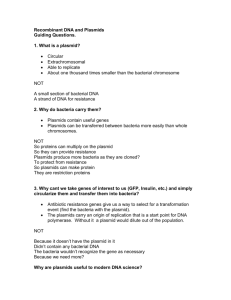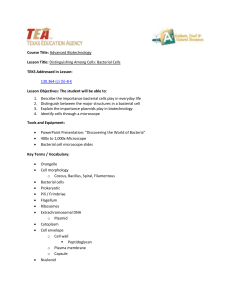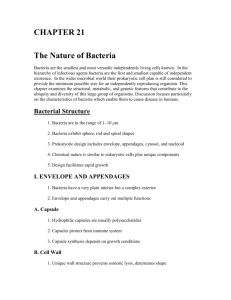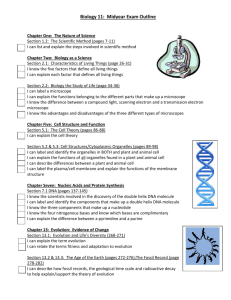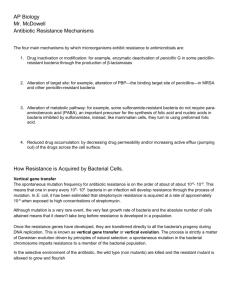Lecture 15: Bacterial Genetics I
advertisement
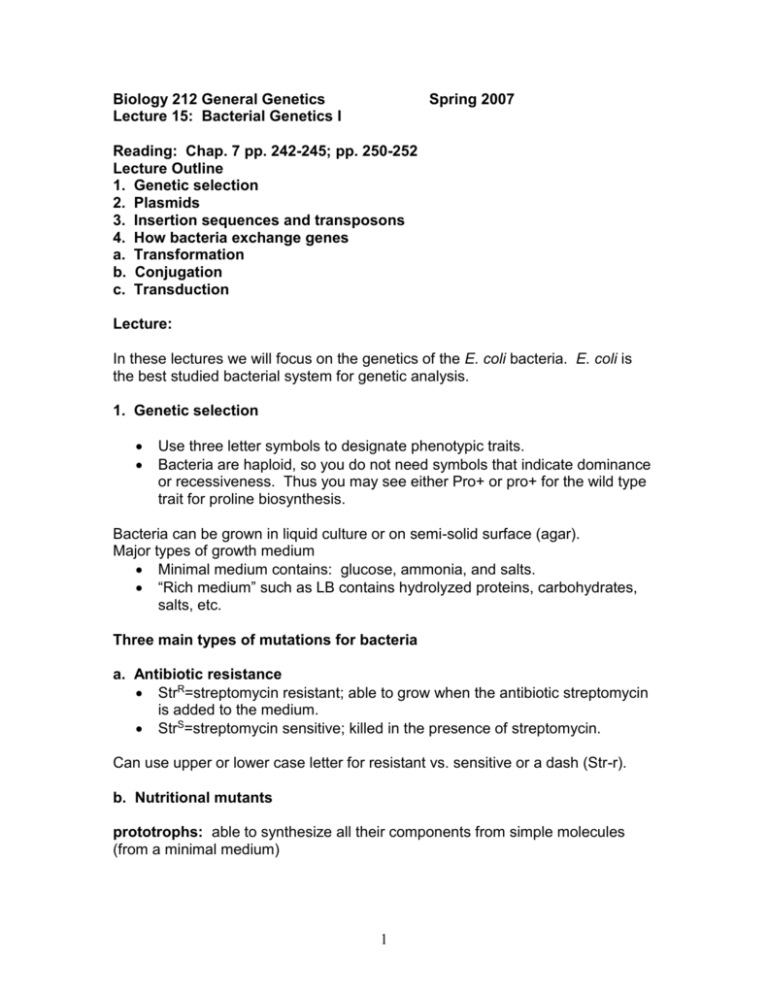
Biology 212 General Genetics Lecture 15: Bacterial Genetics I Spring 2007 Reading: Chap. 7 pp. 242-245; pp. 250-252 Lecture Outline 1. Genetic selection 2. Plasmids 3. Insertion sequences and transposons 4. How bacteria exchange genes a. Transformation b. Conjugation c. Transduction Lecture: In these lectures we will focus on the genetics of the E. coli bacteria. E. coli is the best studied bacterial system for genetic analysis. 1. Genetic selection Use three letter symbols to designate phenotypic traits. Bacteria are haploid, so you do not need symbols that indicate dominance or recessiveness. Thus you may see either Pro+ or pro+ for the wild type trait for proline biosynthesis. Bacteria can be grown in liquid culture or on semi-solid surface (agar). Major types of growth medium Minimal medium contains: glucose, ammonia, and salts. “Rich medium” such as LB contains hydrolyzed proteins, carbohydrates, salts, etc. Three main types of mutations for bacteria a. Antibiotic resistance StrR=streptomycin resistant; able to grow when the antibiotic streptomycin is added to the medium. StrS=streptomycin sensitive; killed in the presence of streptomycin. Can use upper or lower case letter for resistant vs. sensitive or a dash (Str-r). b. Nutritional mutants prototrophs: able to synthesize all their components from simple molecules (from a minimal medium) 1 auxotrophs: mutants unable to synthesize one or more of their components from simple molecules. Examples of nutritional mutants: Pro+ Pro- able to synthesize the amino acid proline unable to synthesize the amino acid proline Nutritional mutants include defects in the synthesis of Amino acids (examples Leu, leucine; Pro, proline, Met, methionine, His, histidine) Vitamins (examples Thi, thiamine; Bio, biotin) Nucleotides Usually the wild type trait is the ability to synthesize the compound (they are prototrophs). Mutants usually are defective in the gene for an enzyme needed to synthesize the compound and thus require that compound to be added to the medium. c. Carbon source mutants Generally these cannot use particular sugars as a source of energy. Example: Mutants in genes in the lactose metabolic enzymes (lac Z or lac Y) cannot use lactose; must be supplied with glucose or some other source to grow. Lac Z+ can grow in medium containing lactose. Lac Z- can’t grow in medium containing lactose. 2. Plasmids: Non-essential DNA molecules in bacteria that replicate independent of the bacterial chromosome. Usually small circular DNAs Some are linear Some are large (example, fertility plasmids) Copy #/cell can vary Encode a few genes Major types: R plasmids: Resistance plasmids. Contain genes for drug or antibiotic resistance. These are the types of plasmids from which most of the recombinant DNA vectors are derived. 2 F plasmids: Fertility plasmids. Involved in transfer of genes between bacteria by conjugation (bacterial mating). 3. Insertion sequences and transposons Many DNA sequences in bacteria are mobile and can be transferred between individuals and among species. Main types of mobile elements: IS elements=insertion sequences 1-3 kb long can be found in plasmids or in the chromosome can mediate integration of plasmids into the chromosome; example F plasmid integration to form an Hfr contain a gene for a tranposase enzyme; regulates mobility of the element transposons larger than IS elements usually contain at least one additional gene, often for antibiotic resistance often are arranged with the resistance gene in the middle, flanked by IS elements contain a gene for a transposase enzyme Significance of mobile elements: Rapidly spread beneficial traits between bacteria, such as drug resistance Responsible for “horizontal transfer” of genes across species boundaries 4. How bacteria exchange genes (overview) a. Transformation: Transfer of naked DNA between bacteria used by Avery, McLeod, and McCarty in early experiments that showed DNA is the genetic material method used to introduce plasmids into bacteria some bacteria can be transformed by simply mixing DNA with bacteria for E. coli and some other bacteria, must pretreat the cells with salt solution (such as calcium chloride) to make the membrane more permeable to take up DNA typically procedure for E. coli involves pretreating cells with calcium chloride, incubation of cells with DNA on ice, brief heat shock, followed by an incubation at 37 degrees C to allow the cells to express the new DNA 3 b. Conjugation: Exchange of genes between bacterial cells by cell to cell contact. Requires one cell to contain the Fertility factor (F plasmid)=donor Other cell must lack the F plasmid=recipient c. Transduction: The exchange of genes from one bacterial cell to another mediated by viruses. Generalized transduction: Any gene can be transferred. Carried out by lytic viruses. Specialized transduction: Only one or two genes can be transferred. Carried out by some lysogenic viruses such as bacteriophage lambda. In Bacterial Genetics Lecture II, we will investigate the process of conjugation. In Bacterial Genetics Lecture III, we will look at the life cycles of viruses and the process of transduction. 4
